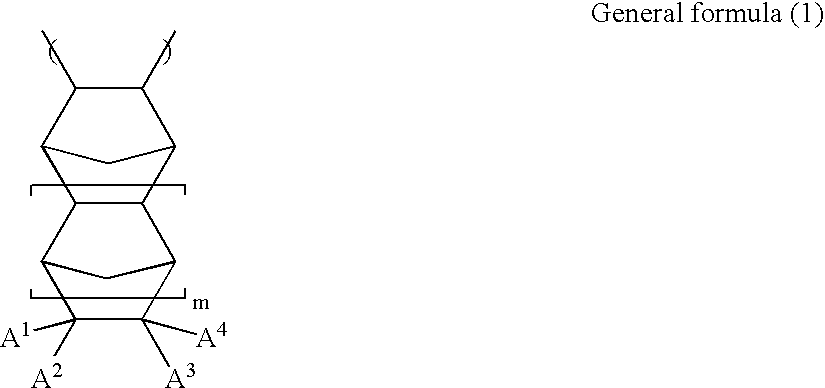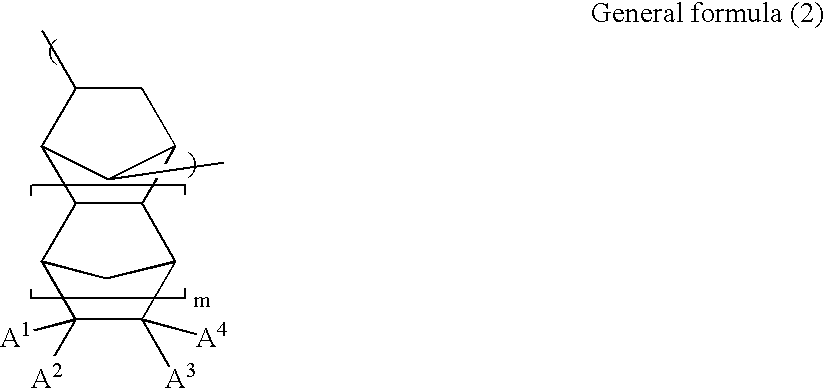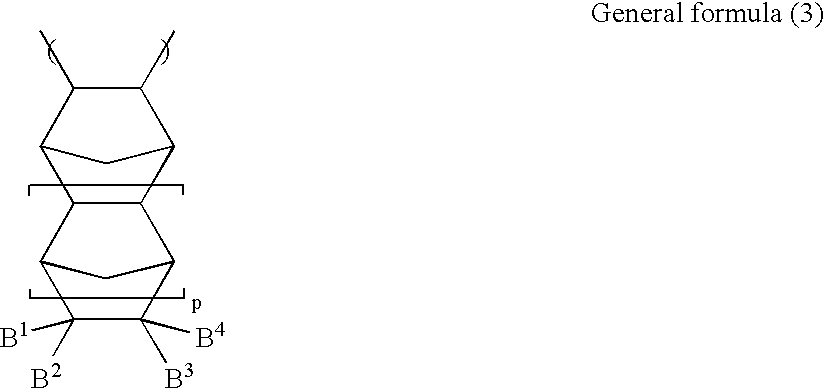Method of forming cavity between multilayered wirings
a multi-layered wiring and cavity technology, applied in the direction of semiconductor/solid-state device details, coatings, solid-state devices, etc., can solve the problems of difficult to obtain low-dielectric constant films, and difficulty in obtaining the film strength necessary for semiconductor device formation processing
- Summary
- Abstract
- Description
- Claims
- Application Information
AI Technical Summary
Problems solved by technology
Method used
Image
Examples
example 1
[0277] 47 g (500 mmoles) of bicyclo[2.2.1]hept-2-ene, 66 g (500 mmoles) of endo-tricyclo[5.2.1.0.sup.2,6]deca-3,8-diene, 0.42 g (5 mmoles) of 1-hexene, and 480 g of toluene and 85 g of cyclohexane as solvents were placed in a 2 liters stainless steel-made reactor under nitrogen.
[0278] A solution of nickel octanoate in hexane and hexafluoroantimonic acid were reacted in a molar ratio of 1 / 1 at -10.degree. C., a precipitate of nickel bis(hexafluoroantimonate) [Ni(SbF.sub.6).sub.2] formed as a by-product was removed by filtration, and the residue was diluted with toluene. The resulting hexafluoroantimonic acid modified material of nickel octanoate (0.40 mmoles as a nickel atom), 1.2 mmoles of boron trifluoride ethyl etherate, 8.0 mmoles of methyl alumoxane, 0.4 mmoles of 1,5-cyclooctadiene, 8.0 mmoles of methyl triethoxysilane were charged in the order of methyl triethoxysilane, 1,5-cyclooctadiene, methyl alumoxane, boron trifluoride ethyl etherate, and the hexafluoroantimonic acid mod...
example 2
[0283] Polymerization was carried out in the same manner as in Example 1, except for using 625 mmoles of bicyclo[2.2.1]hept-2-ene, 587 mmoles of endo-tricyclo[5.2.1.0.sup.2,6]deca-3,8-diene, and 37 mmoles of 5-triethoxysilylbicyclo[2.2.1]hept-2-ene, to obtain a copolymer B in a conversion of 62%. A proportion of the structural unit derived from endo-tricyclo[5.2.1.0.sup.2,6]deca-3,8-diene as determined from the .sup.1H-NMR spectrum was 37 mol %. A proportion of the structural unit derived from 5-triethoxysilylbicyclo[2.2.1]hept-2-ene was 3.0 mol %. (This value was calculated from a ratio of the CH.sub.2 absorption of the Si--O--CH.sub.2-- group at 3.7-4.1 ppm to the absorption of all of other protons.) The copolymer B had a number average molecular weight of 60,000 and a weight average molecular weight of 121,000 as reduced into polystyrene, with an Mw / Mn ratio being 2.0.
[0284] Hydrogenation was carried out in the same manner as in Example 1 at 120.degree. C. for 4 hours under a hyd...
example 3
[0287] Polymerization was carried out in the same manner as in Example 1, except for using 625 mmoles of bicyclo[2.2.1]hept-2-ene, 587 mmoles of endo-tricyclo[5.2.1.0.sup.2,6]deca-3,8-diene, and 37 mmoles of 5-[1',4',4'-trimethyl-2',6'-dioxa-1'-silacyclohexyl]bicyclo[2.2.1 ]hept-2-ene, to obtain a copolymer C. A conversion into the copolymer was 60%. In the copolymer C, a proportion of the structural unit derived from endo-tricyclo[5.2.1.0.sup.2,6]deca-3,8-diene as determined from the .sup.1H-NMR spectrum was 36 mol %. A proportion of the structural unit derived from 5-[1',4',4'-trimethyl-2',6'-dioxa-1'-silacyclohexyl]bicyclo--[2.2.1]hept-2-ene was 3.0 mol %. (This value was calculated from a ratio of the CH.sub.2 absorption of the Si--O--CH.sub.2-- group at 3.4-4.0 ppm to the absorption of all of other protons.) The copolymer C had a number average molecular weight of 116,000 and a weight average molecular weight of 278,000 as reduced into polystyrene, with an Mw / Mn ratio being 2.4...
PUM
| Property | Measurement | Unit |
|---|---|---|
| mol % | aaaaa | aaaaa |
| glass transition temperature | aaaaa | aaaaa |
| elastic modulus | aaaaa | aaaaa |
Abstract
Description
Claims
Application Information
 Login to View More
Login to View More - R&D
- Intellectual Property
- Life Sciences
- Materials
- Tech Scout
- Unparalleled Data Quality
- Higher Quality Content
- 60% Fewer Hallucinations
Browse by: Latest US Patents, China's latest patents, Technical Efficacy Thesaurus, Application Domain, Technology Topic, Popular Technical Reports.
© 2025 PatSnap. All rights reserved.Legal|Privacy policy|Modern Slavery Act Transparency Statement|Sitemap|About US| Contact US: help@patsnap.com



